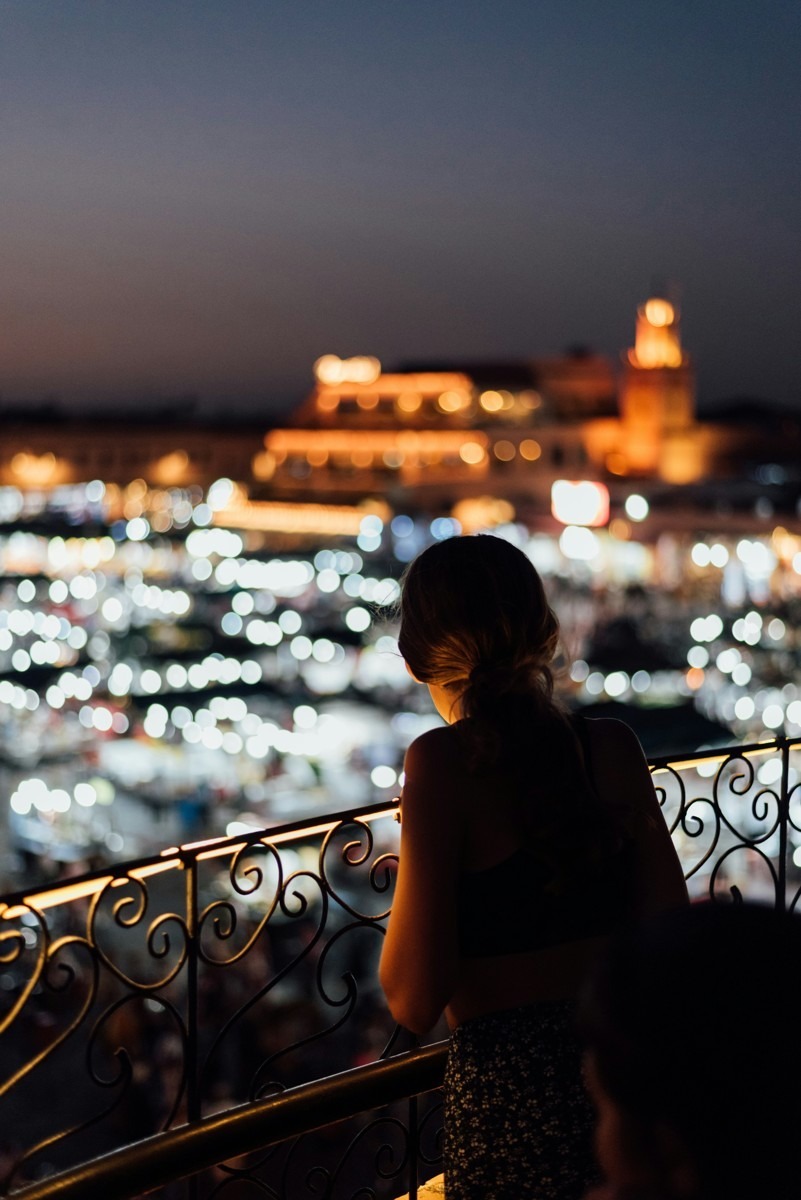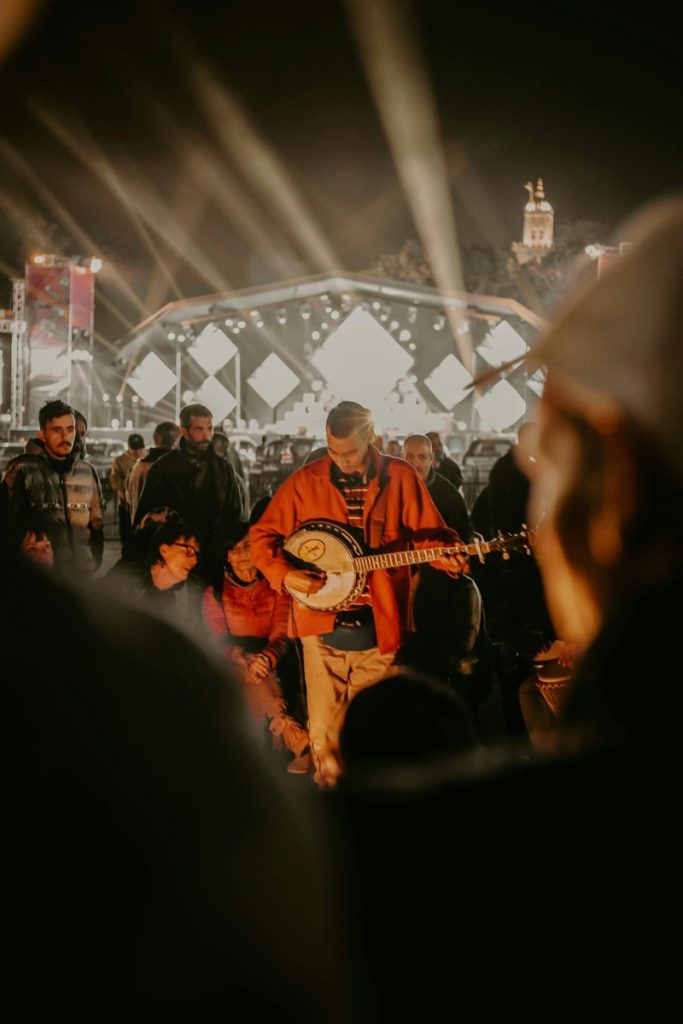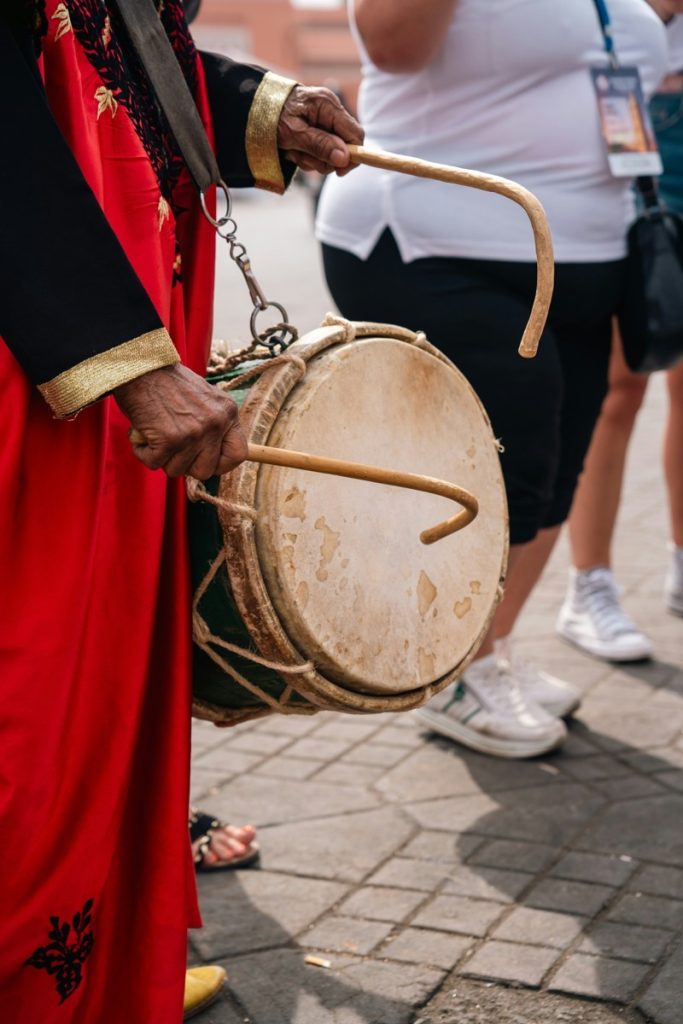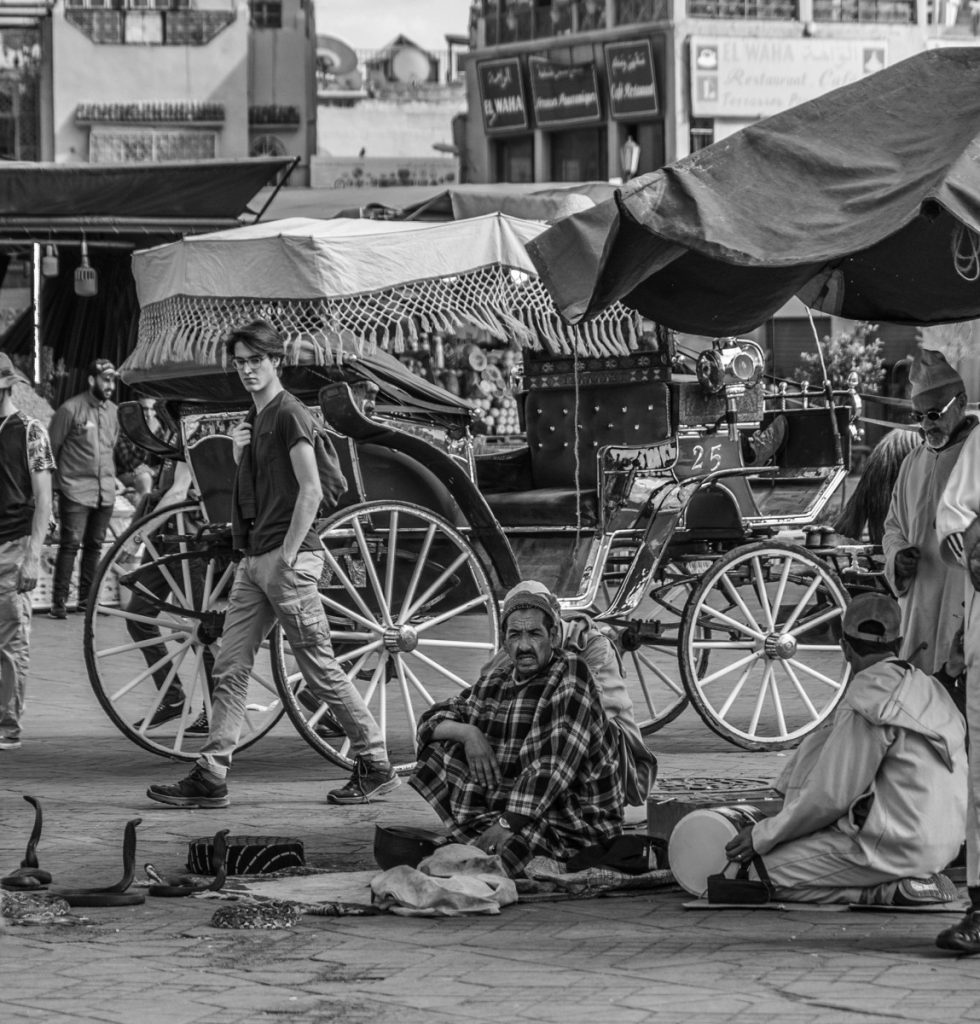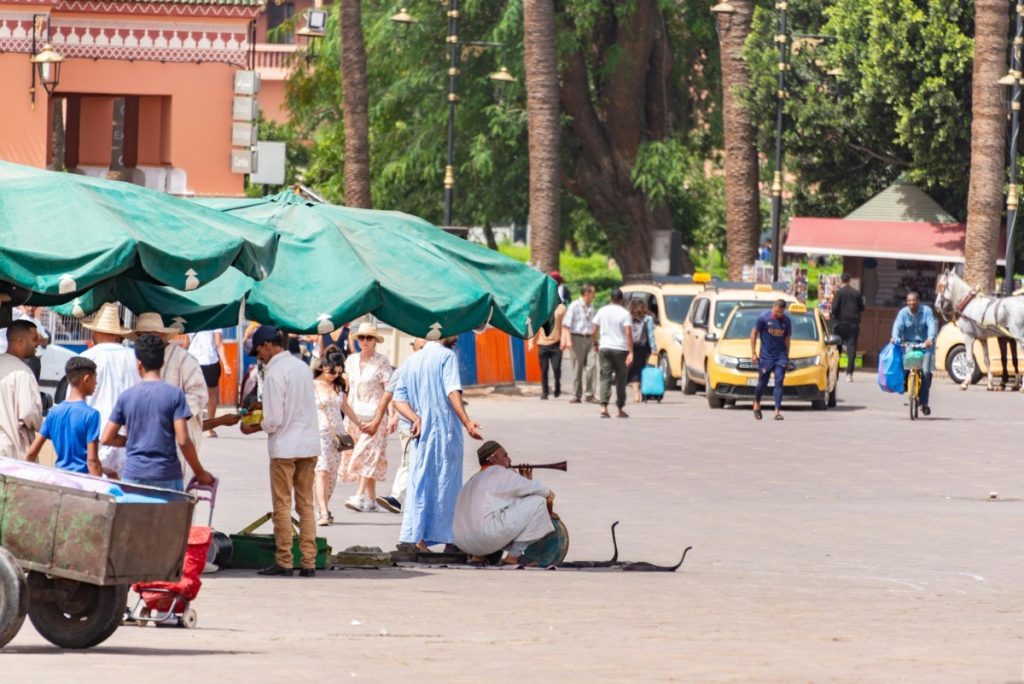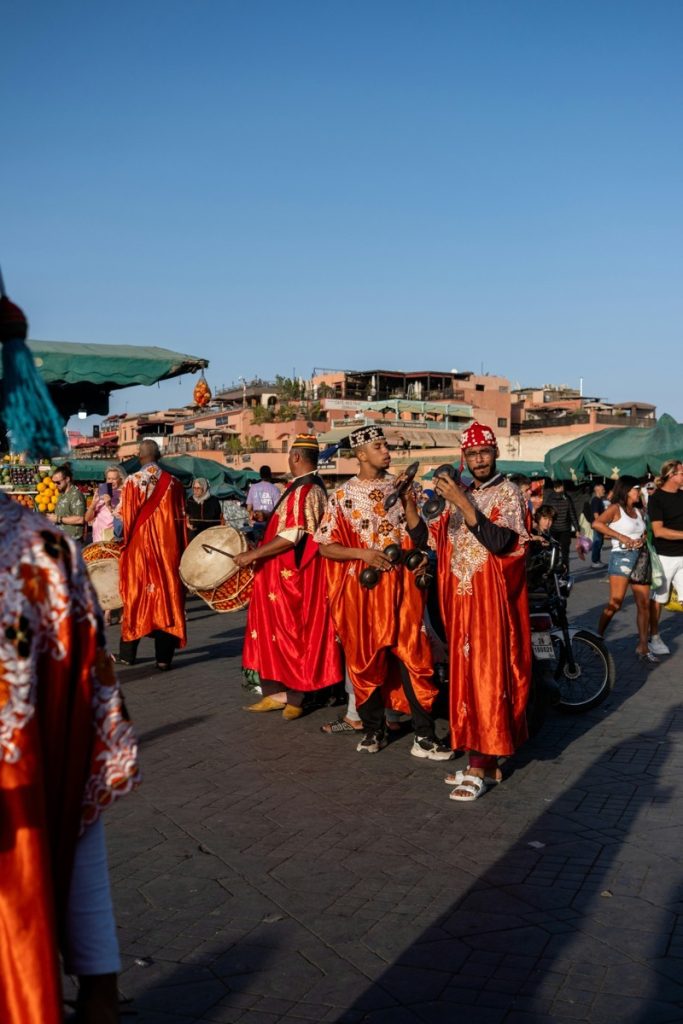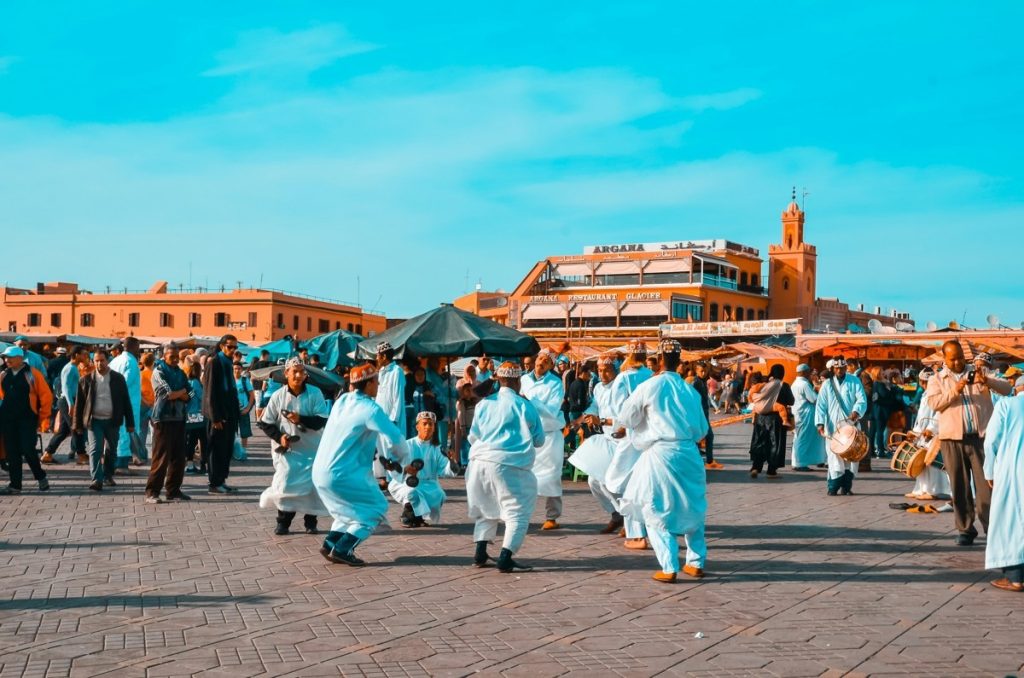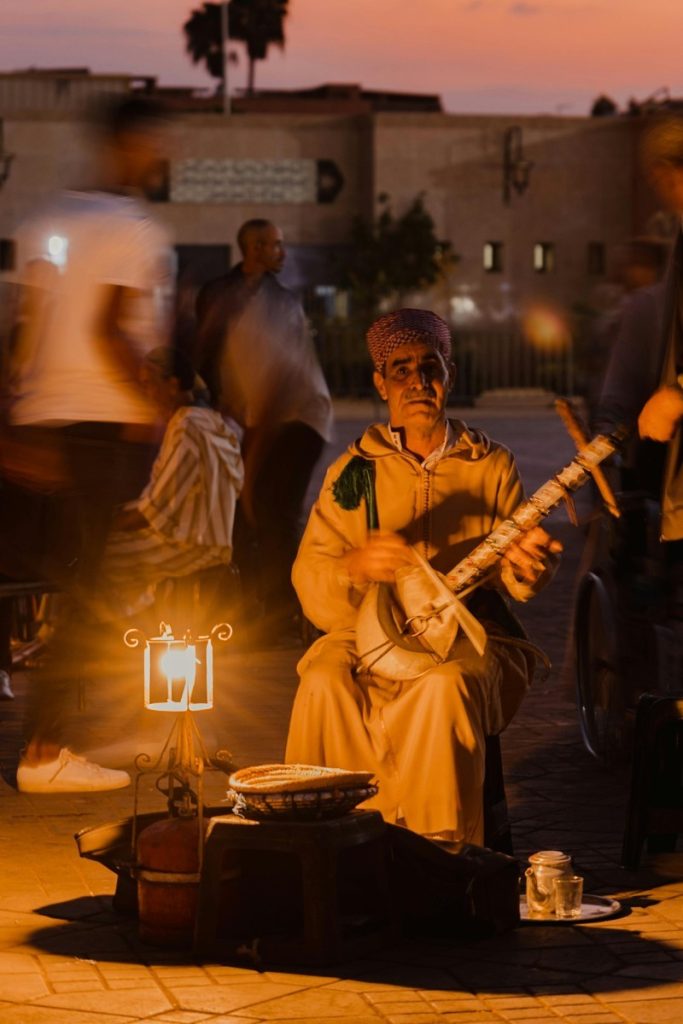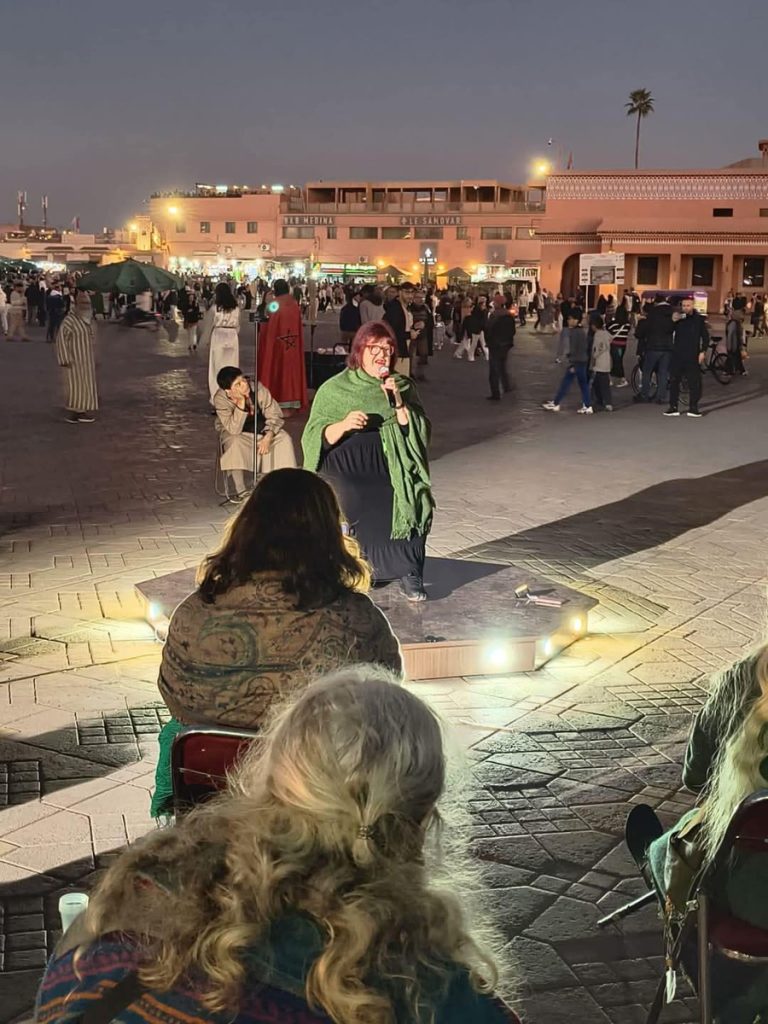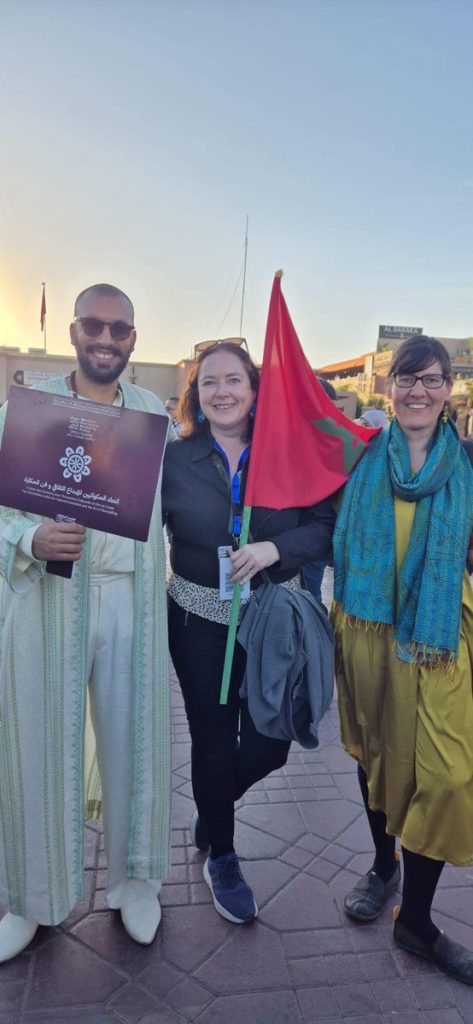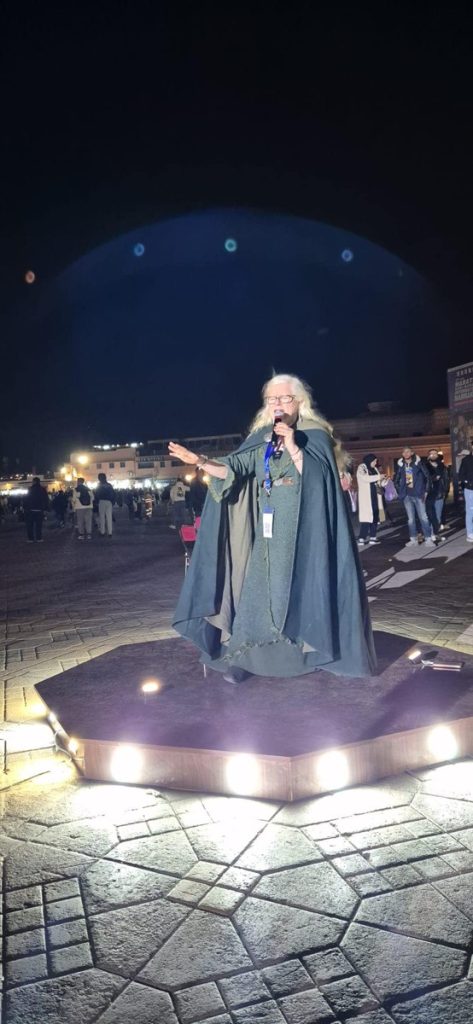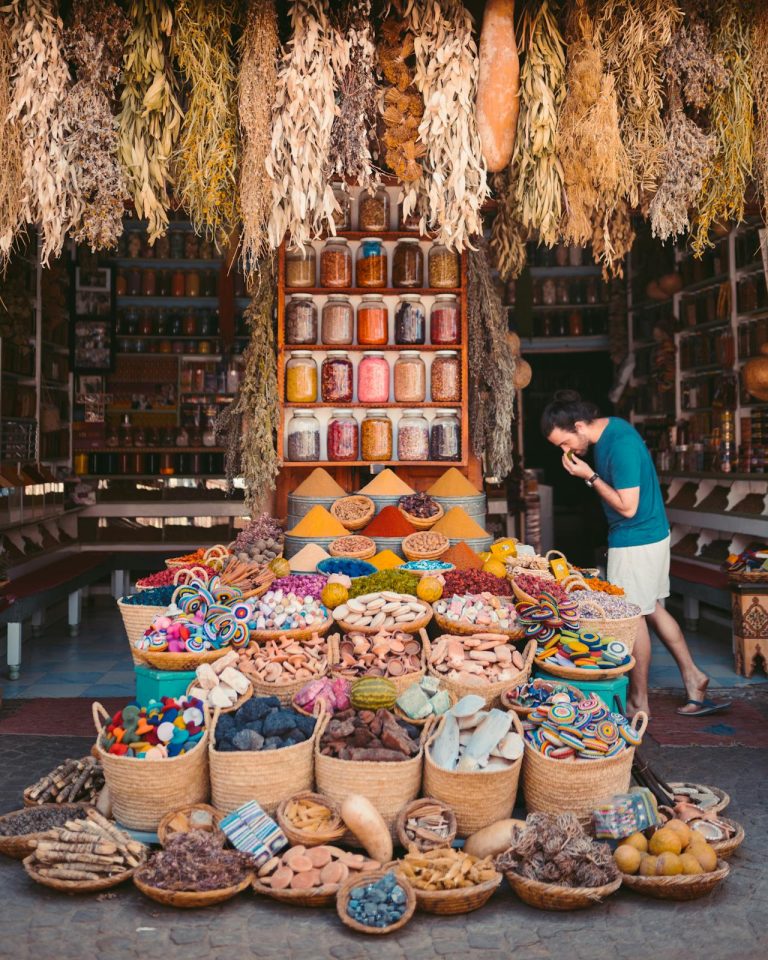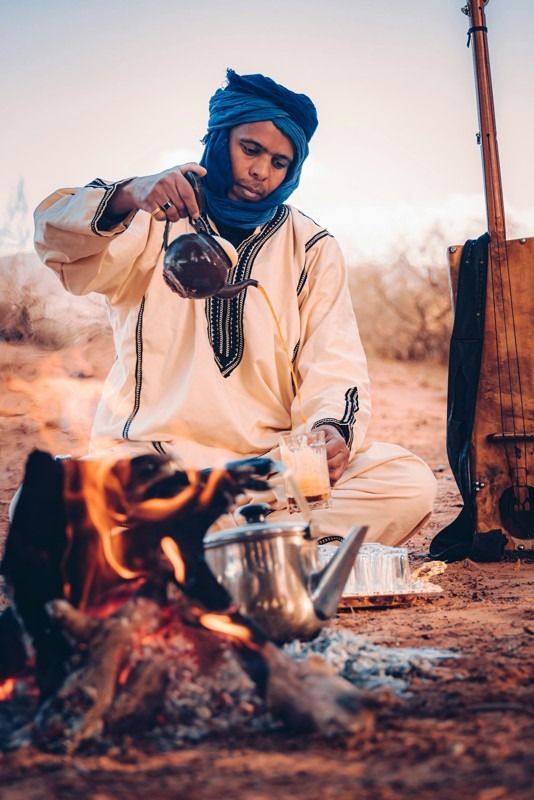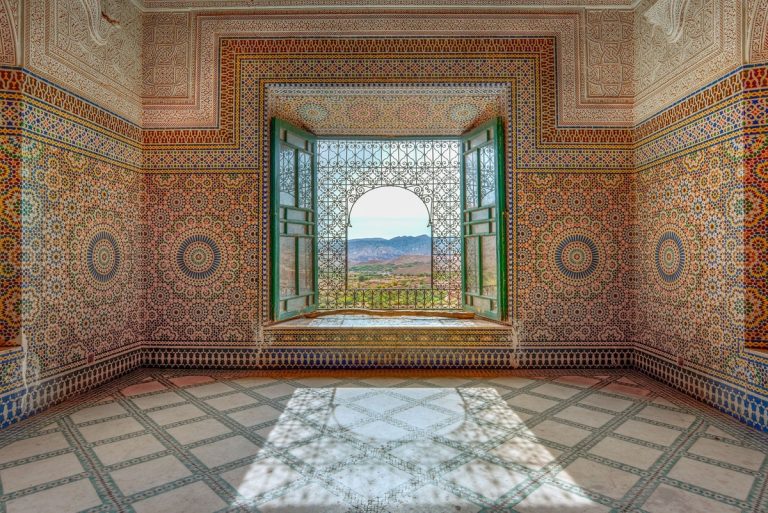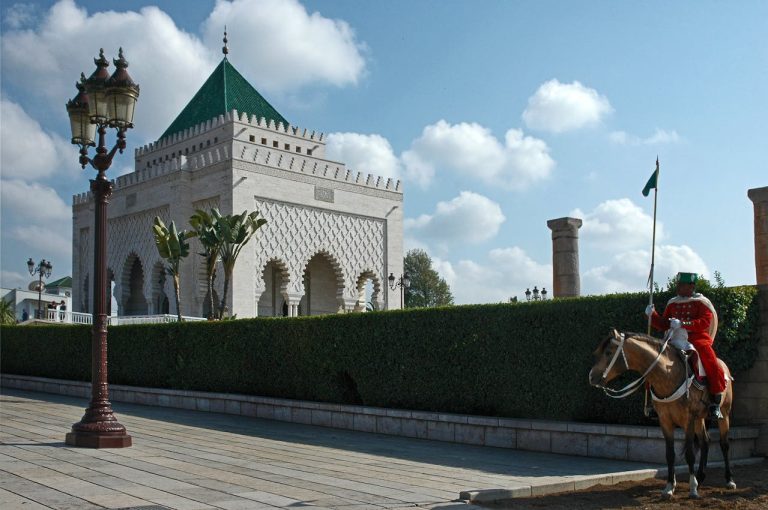Storytelling in Jemaa el-Fnaa: Where Ancient Tales Live
Storytelling in Jemaa el-Fnaa isn’t just entertainment—it’s the living pulse of Marrakech itself, a tradition so vital that UNESCO recognized it as part of humanity’s intangible cultural heritage. I still remember the first time I stood in that square at dusk, watching a circle of people grow around an elderly storyteller whose hands moved like birds through the air, his voice rising and falling with centuries-old rhythms that somehow felt completely… immediate.
Are you familiar with that sensation when you encounter something so genuine that it causes a tightening in your chest? That is the typical scene here each evening, as the sun dips behind the Koutoubia Mosque and Jemaa el-Fna Square evolves from a bustling daytime market into an atmosphere that feels nearly mystical—though I hesitate to use that term, as it can seem overly touristy, and this experience is anything but.
The Soul of Marrakech Speaks Through Story
When people ask me what makes Marrakech different from other Moroccan cities (and they do ask constantly), I always come back to this square. It’s not the riads or even the souks—though we’ll explore those in due course. It’s the storytellers. In Darija, we refer to them as the “hikaya“. These aren’t street performers putting on a show for tourists, though tourists certainly gather. They’re the keepers of oral tradition, the ones who’ve memorized epic tales that stretch back through generations, passing them down through memory and performance rather than the written word.
I grew up hearing my grandmother tell stories in our family courtyard, but even she would pause her tales to listen when we passed through Jemaa el-Fna. “That one,” she’d whisper, pointing to a storyteller surrounded by local men sitting on worn wooden stools, “he knows the complete tale of Antar and Abla.” And we would pause, occasionally for an hour, entranced by the enchantment of a story I had heard fragments of throughout my entire life, yet never quite in this manner.
The Marrakech International Storytelling Festival has brought this ancient art into global consciousness—particularly with this year’s theme, Bahja, which translates roughly to joy and healing but carries so much more weight in Arabic. Upon witnessing Irish storytellers such as Liz Weir and Eimear Burke perform on the same stage where Moroccan hlaykia have been performing for centuries during this year’s festival, a connection was made. Story isn’t bound by language or geography; it’s fundamentally human.
Where Tradition Meets the Modern World
Jemaa el-Fna’s unique quality is its refusal to remain stagnant in time. Yes, it’s ancient—the square’s been the heart of Marrakech’s medina since the city’s founding in the 11th century. But it’s also vibrantly, chaotically alive right now, this very minute. During the day, it’s almost overwhelming in an entirely different way than at night. Snake charmers (controversial, I know, and we should talk about that), water sellers in their gorgeous red costumes with brass cups dangling, young men with Barbary apes on chains (even more controversial—many of us are pushing for this practice to end), and those ubiquitous orange juice stalls where you can get a glass of fresh-squeezed juice for about 4 dirhams if you’re savvy.
But honestly? The daytime square is just the prelude.
As afternoon stretches toward evening, something shifts. The food stalls start setting up—dozens of them, smoke rising from grills, the scent of cumin and paprika and grilled meat filling the air until you can practically taste it. Musicians tune their instruments. And the storytellers begin to claim their spots, the same spots their fathers and grandfathers claimed, marked not by signs but by tradition and respect.
The Art of the Circle
Here’s what happens, and I’ve watched this unfold hundreds of times, but it never gets old: a storyteller arrives, often carrying nothing more than a small stool or sometimes just standing. He (and yes, traditionally they’re men, though this is slowly changing) begins speaking—sometimes just to the air at first. A word here, a phrase there. Maybe he’s warming up, maybe he’s testing which story feels right for this particular evening. Then someone stops. One person becomes two, two becomes five, and suddenly there’s a half-circle, then a full circle, then people standing three-deep trying to hear.
The traditional Moroccan storytelling technique combines elements of performance art, literature, standup comedy, and religious sermons into a unique form of expression. The storyteller modulates his voice from whisper to shout, acts out different characters, and uses pregnant pauses that would make a theater director weep with envy. He’ll tell fragments of epic tales—stories from the Arabian Nights, the adventures of Antar ibn Shaddad, local legends about saints and djinn, and clever peasants who outwit greedy sultans.
During the Celebration of Irish and American Stories in the square this past year, which took place on a Tuesday evening while I was there with my cousin, a cultural anthropologist, I experienced a memorable moment watching Western storytellers perform alongside Moroccan hlaykia under the stars. Danni Cullen was telling a story—I can’t remember which one—and an elderly Moroccan storyteller was watching, nodding worldwide, worthy of preservation and celebration.
Aoife Demel from Storytellers of Ireland spoke at one of the festival events about how Ireland had to fight to preserve its storytelling traditions and how they nearly lost the seanchaí tradition entirely. There’s this beautiful synchronicity between Celtic and Arabic oral traditions—the emphasis on memory, on rhythm, and on the story adapting slightly with each telling while maintaining its essential truth.
Beyond the Circle: Exploring the Square’s Layers
The storytellers are the heart, but the square itself is its own complex ecosystem. On one side, you’ve got the entrance to the Marrakech Souk—that labyrinthine traditional market where you can buy everything from spices to leather babouches to questionable “antiques” (if you locate a genuine antique in the tourist section, I’ll eat my djellaba). The souk is where locals actually shop for daily necessities, though you wouldn’t know it from the tourist-facing sections.
The other sides of the square open onto hotels that range from barely one-star to genuinely luxurious, gardens where you can escape the chaos for a moment, and those famous cafe terraces where you can sit with a mint tea and watch the spectacle unfold below. I have complicated feelings about those cafes—they offer a buffer, a way to observe without fully participating, which can be useful for overwhelmed first-timers. But they also create this weird dynamic where the square becomes a show, with tourists as the audience rather than participants.
The narrow streets radiating from Jemaa el-Fna lead deep into the medina quarter, into neighborhoods where daily life happens largely unchanged by tourism. If you have the courage to become lost (and you should, honestly—that’s where the real magic lives), you’ll stumble upon neighborhood mosques, hammams that have been operating since the 18th century, bakeries where people bring their bread dough to be baked in communal ovens, and children playing football in alleys barely wide enough for a donkey cart.
The Transformation at Dusk
I keep coming back to this because it’s genuinely the most striking thing about the square: the transformation that happens as day turns to night. During the day, Jemaa el-Fna is hot, dusty, and slightly overwhelming—a marketplace like many others, just bigger and more famous. But as the sun starts to set (and Marrakech sunsets are spectacular, all orange and pink reflecting off the Atlas Mountains), the entire energy shifts.
The food stalls are fully operational now, each one numbered and registered (there’s actually serious competition for stall spots, passed down through families). You can get anything: harira soup, grilled merguez, tagines prepared right there, snails in spicy broth (bebbouche—an acquired taste but beloved by locals), sheep’s heads (not for everyone, granted), fresh sardines… The smoke, the smell, the calls of vendors trying to lure you to their stall—it’s sensory overload in the best possible way.
The traditional music starts up. Gnawa musicians with their guembris (three-stringed bass lutes) and metal castanets create rhythms that have roots in sub-Saharan Africa, brought north centuries ago by enslaved people and now one of Morocco’s most distinctive musical traditions. Berber musicians play loutar and sing in Tachelhit or Tamazight. Groups of young men perform acrobatic displays—backflips, human pyramids, and feats of strength and balance that would make any circus proud.
In their designated circles, the storytellers continue to weave their narratives through all of it. Their voices compete with musicians and food vendors and the general din of thousands of people in one square, but somehow they cut through. If you stand still for a moment and let your ears adjust, you’ll find yourself drawn to a particular voice, a particular cadence, pulled into a story despite not understanding every word.
Practical Wisdom for Story Seekers
If you’re coming to Marrakech specifically for the storytelling (and that’s a valid reason—I’ve met people who’ve done exactly that), here’s what you need to know:
The best time is between 7 PM and 10 PM, particularly in the cooler months (October through April). Summer evenings are scorching, and while the storytellers still perform, both they and their audiences are visibly wilting. Spring and fall offer perfect weather, though they’re also peak tourist seasons, so expect serious crowds.
The storytellers perform in Darija (Moroccan Arabic), sometimes mixed with classical Arabic, and honestly, unless you speak Arabic fluently, you won’t understand most of it. But—and this is crucial—you don’t need to. Watch the audience reactions. Watch the storyteller’s face, his hands, and his body language. Listen to the rhythm and flow. I’ve seen the story arc—introduction, rising tension, climax, resolution—play out clearly through pure performance; no translation is needed.
If you want more profound understanding, consider hiring a local guide who can translate and provide context. My friend Rashid does walking tours that include the evening storytelling, and he’s brilliant at whispering translations without disrupting the performance. There are also occasional performances during the Marrakech International Storytelling Festival with English translation or bilingual storytellers.
Don’t photograph without asking. Some storytellers are fine with it (especially if you’ve been watching for a while); others consider it disrespectful. Always offer a small tip if you’ve been photographing.
The Food Element: Stories Around the Stalls
Here’s something wonderful about Jemaa el-Fna Square that connects directly to storytelling: eating at the food stalls naturally creates narrative. You sit down at stall number 14 (my personal favorite, run by the same family for three generations), and suddenly you’re in conversation. Where are you from? Are you visiting Marrakech for the first time? Let me tell you about this dish. My grandfather started this stall in 1959. This spice blend is his secret recipe.
The traditional Moroccan food itself tells stories—recipes passed through families, ingredients that mark seasons and celebrations, and cooking techniques that haven’t changed in centuries. The tagine slow-cooking over coals isn’t just a meal; it’s a connection to every grandmother who’s made the same dish the same way, a direct line to the past.
I remember sitting at one of these stalls with a journalist from The New York Times (this was for that sustainable tourism article I was quoted in), and we got into this long conversation with the stall owner about how tourism has changed the square. He was ambivalent—grateful for the business, worried about authenticity being commodified, proud that his children were getting university educations but sad they had no interest in continuing the stall. There was also a different type of storytelling, one that was more modern but still held significant value.
The Cultural Controversy: Preservation vs. Evolution
Look, I need to address something that makes people uncomfortable: not everyone in Morocco is thrilled about how Jemaa el-Fna functions today. Some intellectuals and cultural critics argue it’s become a tourist spectacle, a theme park version of authentic culture. Critics argue that the snake charmers often mistreat their defanged snakes, that chained monkeys, which are increasingly banned but still present, are a problem, and that some of the “traditional” performances are staged rather than genuine.
There’s truth to this. Tourism changes everything it touches. When storytellers know their audience is 80% foreign tourists, do they adapt their material? They do—they’re human, they’re practical, and they need to eat. When a performance becomes a tourist attraction, is it still authentic? That’s a complicated question without straightforward answers.
But here’s what I think, and I’ve spent years wrestling with this: culture isn’t static. It has never been. For hundreds of years, the storytelling tradition in Jemaa el-Fna has been changing, adding new stories, adapting to new audiences, and staying alive because it is flexible instead of frozen. The collaboration between Moroccan storytellers and international festivals such as Ireland’s Yarn Festival exemplifies evolution rather than corruption. The Storytellers Union for Cultural Innovation recognizes that innovation is necessary for survival—that’s wisdom, not selling out.
Would I prefer there were more young Moroccans in those storytelling circles? Absolutely. Am I concerned that economic pressure is changing the nature of the performances? Yes. But am I glad the tradition is still alive, is still being practiced, and is still captivating audiences, even if many of them are tourists? Also yes.
When Story Becomes Medicine
This year’s festival theme—Bahja, joy, and healing—resonated with me more deeply than previous years’ themes. We’ve been through so much collectively (pandemic, economic stress, political upheaval), and there’s something about gathering in a circle to hear a story that feels almost therapeutic. This is not a superficial, wellness-industry approach, but one that is truly healing.
I watched a storyteller named Abdelhaq perform during the festival’s closing night. He told a story I’d heard variations of before—about a merchant who loses everything but finds wisdom through his losses. Normally it’s a fairly straightforward moral tale. That night, his performance became something else, as the audience, filled with people from dozens of countries who had come together specifically for stories, reflected everything that had happened in the world. People were crying. Not because the story was particularly sad, but because it felt like he was speaking directly to our collective exhaustion, offering comfort through narrative.
That’s when I truly comprehended, not just on an intellectual level but deep within my being, why UNESCO designated this tradition as worthy of protection. Stories aren’t just entertainment or cultural artifacts. They’re how we process experience, discover meaning, connect across differences, and remember who we are and where we’ve come from.
Connecting With Other Experiences
If you like to tell stories, there are other things about Marrakech that will speak to you. The Ben Youssef Madrasa is a building that tells stories through its intricate carved cedar and zellige tilework. The Bahia Palace demonstrates narrative through design—each room, each courtyard building on the previous one like chapters in a book. Even the medina’s maze of souks tells the story of medieval urban planning, trade routes, and artisan traditions.
The Art of Storytelling extends beyond Jemaa el-Fna into cafes where poets still gather, into private homes where families preserve oral histories, and into music, dance, and craft. If you attend a gnawa lila (night ceremony), you’ll experience musical storytelling that can last until dawn, each song a chapter in a spiritual narrative.
My Honest Recommendation
Should you go? Yes, absolutely—but with realistic expectations. Jemaa el-Fna Square can be overwhelming, occasionally frustrating, and sometimes uncomfortable. It’s crowded, with people constantly asking, pushy, and intense. The poverty is visible. The animal treatment is sometimes disturbing. It’s possible to encounter harassment, overspend on items, and experience a sense of intimidation and discomfort.
But it’s also extraordinary. There’s nowhere else quite like it, nowhere else where you can stand in the same square where stories have been told for nearly a thousand years and hear those stories still being told, still captivating audiences, still evolving while remaining somehow essentially unchanged.
Go around 6 PM. Get oriented during the golden hour when things are transitioning. Grab fresh orange juice (definitely do not pay more than 6 dirhams). Wander through the souk for a bit—get a little lost; it’s fine. Then, as evening properly settles, find a storytelling circle and just… be there. You don’t need to understand every word. Watch faces. Listen to rhythm. Let yourself be pulled into the narrative.
Afterward, eat at the food stalls (seriously, overcome any hesitation about street food—it’s delicious and generally safe). Go to a terrace café for dessert and mint tea with a view of the square.
FAQ: What Travelers Are keen to Know
The Last Word
Storytelling in Jemaa el-Fnaa represents something increasingly rare in our modern world: living tradition. Not present This tradition, rather than being preserved in amber or reconstructed for tourists, is alive—messy, evolving, economically dependent on tourism, yet somehow transcending it.
Every time I stand in that square at sunset, watching the first storyteller begin his performance, watching that first circle form, I’m reminded that humans have been gathering like these groups for as long as we’ve had language. The connection between fire and story, story and community, and narrative unites us despite our differences.
Morocco has given the world many gifts—architecture, cuisine, music, and craft. But maybe the most important thing is this: it reminds us that stories are important, that oral tradition still has power, and that people still gather in a circle to hear someone speak truth, legend, and wisdom.
Come to Marrakech. Stand in Jemaa el-Fna as the sun sets and the square transforms. Discover a storytelling circle and immerse yourself in rhythms beyond your comprehension. Although you might not understand every word, the story will resonate deeply within you—and isn’t that what we’re all seeking in the first place?
Note: Information about the Marrakech International Storytelling Festival and cultural partnerships comes from direct participation and coverage by cultural institutions. The UNESCO designation of Jemaa el-Fna’s oral traditions can be verified through UNESCO’s Intangible Cultural Heritage listings.

